Pragnav Bodh Part 02 Full Book
Added to library: September 2, 2025

Summary
This is a summary of the Jain text "Pragnav Bodh Part 02 Full Book," compiled from the provided pages. The book, authored by Bramhachari Paras Jain and published by Shrimad Rajchandra Ashram, offers a detailed exploration of Jain philosophy and spiritual practices, primarily focusing on the concept of 'Agya' (obedience/command) and 'Samadhi-maran' (contemplative death).
Overall Theme:
The book emphasizes the paramount importance of following the guidance of a true Guru (Sannyaguru) and adhering to their teachings and commands for spiritual liberation. It delves into the nature of reality, the cycle of birth and death, the futility of worldly pursuits, and the path to achieving spiritual purity and ultimately, liberation (Moksha).
Key Concepts and Sections:
Part 1: Pragnav Bodh Part 02 (Pages 1-15)
- Introduction: The book is presented as a commentary on Shri Brahmachariji's work, "Pragnav Bodh." It highlights the author's profound scriptural knowledge, poetic skill, and deep devotion to Lord Shrimad Rajchandra. The text is based on Shrimad Rajchandra's own instructions in his letters, incorporating his letters to further strengthen the understanding of the concepts.
- Content Structure: The book is organized into various chapters (Pudhyank/Vishay) covering a wide range of Jain teachings, including:
- Agya (Chapter 51): This is a central theme, emphasizing the importance of obedience to the Guru's commands as the true path to liberation. It contrasts this with worldly desires and attachments, which lead to further suffering. The text stresses that even virtuous acts performed without obedience can lead to worldly gains rather than spiritual liberation.
- Karma and its Rules: Discussions on the principles of karma, including Bandh (bondage), Uday (manifestation), Uddeerana (premature manifestation), and Satta (dormant state).
- Spiritual Disciplines: Topics like Munidharma (duties of monks), the nature of attachment, impermanence of worldly connections, and the importance of equanimity.
- Theological Concepts: Discussions on the significance of various Tirthankaras, the path to becoming a Tirthankar, and the principles of Ahimsa (non-violence).
- The Importance of a Guru: The text repeatedly highlights the role of a true Guru as a guide, physician, and source of spiritual knowledge, whose guidance is essential for overcoming obstacles and achieving liberation.
- The Nature of Reality: The book touches upon the impermanence of worldly things, the illusions of worldly happiness, and the ultimate reality of the soul.
- Living by the Guru's Word: A strong emphasis is placed on living by the Guru's every word, discarding personal opinions, and seeking inner experience through their guidance.
Part 2: Samadhi-Maran (Chapters 52-54, 72-74, 80, 82, 83, 84, 86, 90, 91, 92, 93, 94, 95)
- Samadhi-Maran (Chapters 52-53): This section focuses on achieving a state of contemplative death, which is considered the key to liberation. It describes the process of detaching from worldly possessions and relationships, maintaining equanimity, and focusing the mind on the true self even in the face of suffering and death. The text draws parallels with the lives of great souls who achieved liberation through such practices. It also elaborates on the importance of righteous actions, controlling desires, and the significance of the Guru's guidance in achieving this state.
- Vaitaliya Adhyayan (Chapter 54): This chapter explores the teachings from the Shrutaskandha, specifically the Vaitaliya Adhyayan, which emphasizes detachment and the impermanence of worldly existence. It uses the story of Rishabhnath's sons to illustrate the path of renunciation.
- Nirjara Kram (Chapter 82): This part discusses the process of shedding karma. It highlights that true liberation comes not just from external rituals but from inner purification, controlling kashayas (passions) and cultivating virtues like compassion and equanimity.
- The Importance of Samity and Gupiti (Chapter 79): This section delves into the practical aspects of monastic discipline, emphasizing the five Samitis (careful conduct) and three Guptis (restraint of mind, speech, and body) as essential for spiritual progress.
- Adhyatma (Chapter 70): The concept of Adhyatma (self-contemplation/spirituality) is explained as the path to realizing the true nature of the soul. It stresses the importance of detaching from the physical body and worldly illusions to attain inner peace and self-awareness.
- Pancha Param Pad (Chapters 61-63, 67-68): This segment discusses the five supreme beings in Jainism: Arihant, Siddha, Acharya, Upadhyay, and Sadhu. It highlights their virtues and the path to attaining such exalted states, emphasizing devotion and adherence to their teachings.
- Vairatva (Chapter 87): This chapter focuses on the concept of 'Veerattva' (heroism) in the spiritual context, emphasizing the need to overcome internal enemies like passions and attachments with the strength derived from spiritual knowledge and devotion.
- The Goal of Samadhi-maran: The ultimate goal discussed is achieving Samadhi-maran, a state of deep contemplation and detachment at the time of death, which leads to liberation.
- The Role of the Guru: The text consistently points to the Guru as the indispensable guide who illuminates the path to understanding these concepts and achieving spiritual goals.
Key Takeaways:
- Agya (Obedience to the Guru): Following the Guru's commands is presented as the most direct path to spiritual progress and liberation.
- Detachment from Worldly Affairs: The book consistently advises renouncing worldly attachments, desires, and illusions, as they are considered impermanent and a source of suffering.
- Inner Purity and Self-Realization: The ultimate goal is to realize the true nature of the soul, which is pure, eternal, and free from the cycle of birth and death. This is achieved through introspection, meditation, and adherence to Jain ethical principles.
- The Power of Spiritual Knowledge: The text emphasizes that true understanding comes not just from studying scriptures but from the guidance of a realized Guru and their living example.
- Perseverance: The path to spiritual liberation is arduous and requires constant effort, perseverance, and unwavering devotion to the Guru and the principles of Jainism.
In essence, "Pragnav Bodh Part 02" serves as a guide for spiritual seekers, offering profound insights into Jain philosophy, the importance of a Guru's grace, and the practical steps towards achieving self-realization and liberation.